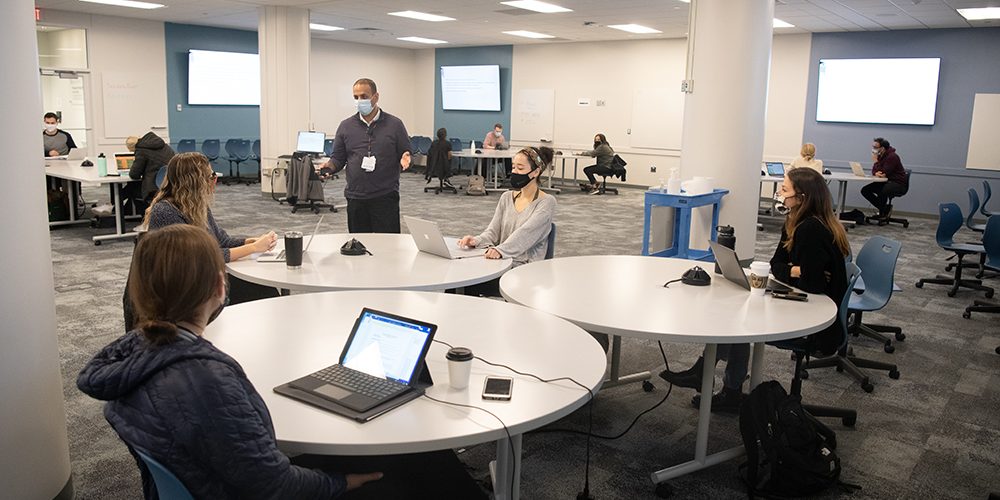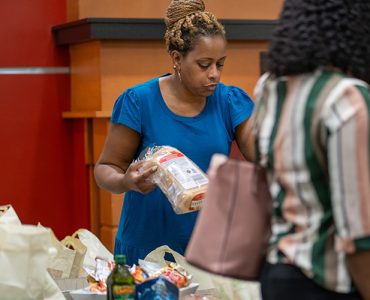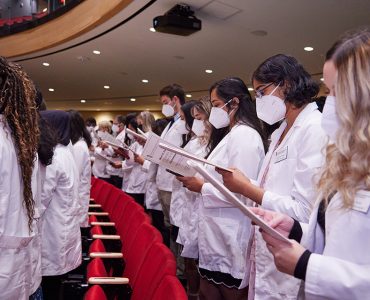Their days start with checking their temperatures and filling out a symptom-monitoring form.
Their worries range from child care to transportation to their health.
Some wonder when it will be safe to travel to see their families, whether their studies will be pushed back, or if the COVID-19 pandemic will affect their job prospects.
For the 7,100 students at the University of Maryland, Baltimore (UMB), the pandemic has brought a wave of uncertainty, even as some have resumed in-person learning this fall in small group classes, at research labs, or at the medical center.
“What worries me the most is the uncertainty because I am trying to finish up my research in spring next year,” says Nivedita Hegdekar, a seventh-year graduate student in the Biochemistry and Molecular Biology program in the Graduate School. “If we have to go into another lockdown, how is this going to affect my work?”

In March, as the coronavirus pandemic hit the United States, the University and its six professional schools and interdisciplinary Graduate School had to limit in-person learning and other activities to protect the safety of students, faculty, staff, and the community. This was a blow to many students who conduct research, work with patients, and savor collaboration with faculty and fellow students.
This fall, some students have returned to campus, albeit with safety protocols in place. The schools offer a mix of virtual and experiential learning opportunities. For the School of Medicine, first- and second-year students are taking a hybrid of in-person and virtual courses while third- and fourth-year students are fully in-person conducting clinical rotations. About 250 Graduate School students are on campus working on their thesis and dissertation research. At the School of Dentistry, didactic instruction is being conducted virtually while students are on campus for clinic and lab simulation sessions. And the School of Nursing returned to hands-on learning during the summer.
“The vast majority of students have been wanting to jump in and get going,” says Larry Fillian, MEd, associate dean for student and academic services, School of Nursing.
Confronting Challenges
Patty Alvarez, PhD, MS, assistant vice president of student affairs, Office of Academic Affairs, says that many students are experiencing child care issues among other concerns this fall.
“Balancing in-person and/or virtual experiences — on top of caregiving and health safety concerns that individual students have or perhaps their family might have — have all been challenges,” she says. “The campus has done a really good job of outlining COVID-19 health safety requirements that all students, faculty, staff, and visitors must follow.
“In addition, most face-to-face resources offered by the University and schools can be accessed via a virtual platform. New resources and offerings are also being provided. I think these efforts help many, but don’t relieve all of the challenges.”

Second-year dental student Ji Hye Park is among the students who have faced challenges since March. Park, who comes to campus three times a week for lab sessions and is a mom to a 4-year-old, says last semester was difficult once in-person learning stopped in the spring and her son’s daycare shut down.
“I’m a full-time student, and I had to take care of my son at home at the same time I had to take online classes and exams at home,” says Park, whose husband is an oncologist. “So that was a very challenging time. This semester, he goes to daycare, so it’s a little bit better, but at the same time I’m a little bit worried because if I could, I would like to keep him at home. But I don’t have any other options.”
She says that with the pandemic, she has the added burden that if her son has cold symptoms or daycare is closed, she now has to stay home with him and can’t go to campus.
Hegdekar, the University Student Government Association president, is one of about 300 international students at UMB. She says a lot of students like herself have not been able to travel home to see family because of the pandemic.
“My grandmother fell ill during this time, she was getting on in life, and I didn’t get a chance to see her before she passed,” says Hegdekar, who initially had planned to travel to see her family in India during the summer. “When I talked to her, she asked, ‘When are you coming?’ In that way it was really very humbling because I realized a lot of people cannot go home and see their loved ones.
“I know a lot of people, especially graduate students who could not go home, they were stressed out with the isolation. A lot of international students particularly don’t know when they’ll go home next.”
“The first day I was in person, it was just such a high-energy, joyous occasion.”
– Alexis Green, second-year medical student
Park, whose family lives in South Korea, says she initially was worried for her own health being on campus, but the University’s efforts to keep everyone safe have calmed her fears.
“I was afraid because whenever people gather, you are worried about COVID,” she says. “But the school did a lot of planning, so now you don’t have that many students in one classroom. The school takes the COVID thing very seriously.”
In addition to implementing the SAFE monitoring form that students and employees must fill out before coming to campus, the University requires face coverings; has posted signs limiting the number of people in elevators, rooms, and gathering places; promotes physical distancing; requires completion of an online training course about how to remain safe on campus; and has required COVID-19 testing at different times during the semester.
“So far I’ve gotten three COVID tests,” Park says. “It’s not a very pleasant experience, but you feel very safe when you and everyone else around you are getting the test and you have to get the negative test to be at school. So it has been a pretty good experience.”
‘Joyous Occasion’
Students have been happy to reunite in person with their classmates.

“The first day I was in person, it was just such a high-energy, joyous occasion to see classmates I hadn’t seen in months in person and learn from a faculty member in person,” says second-year medical student Alexis Green, who traveled home to Indiana in March, completed the spring semester at her childhood home, and returned to Baltimore in the summer.
“Many of us are savoring those in-person moments where you get to have the more collaborative, more natural interaction with classmates and professors.”
Jordan Fraker, a fourth-year pharmacy student who is on a clinical rotation at the University of Maryland Medical Center Midtown campus this fall, calls being in person “beneficial to my learning.”
“Having that in-person interaction with the pharmacy team members as well as the other team members — physicians, nursing staff, medical residents — really helped advance my professional development and give me a better overview of what role pharmacists can have in the hospital setting,” she says.

Green, who comes to campus once a week for her small-group class, says students meet in two large rooms. They sit physically distanced and are not allowed to move the chairs so that they remain apart. The students and the preceptor wear masks in the small-group class, which has 20 students.
“We typically spend almost two hours walking through cases or questions that are relevant in a more active way to the lecture material that we’re learning that week,” Green says. “It’s a really great time for me to collaborate with my classmates and bounce ideas off of each other. And we also get that faculty preceptor in person, the ability to ask some questions or ask for clarification about the lecture material.”
Park, who is on campus about 10 hours a week for an endodontics lab as well as an edentulous patient lab in which the students make dentures, also praises the small-group sessions.
“It’s good because we have less student-to-faculty ratio now compared to the previous classes,” says Park, who points out that it was hard to ask questions or get feedback when classes had to abruptly shift online in the spring.
Students say there are also challenges with trying to balance virtual lectures and on-campus small groups.
“Time management is an issue,” Park says. “When we have classroom lectures, I go to school every day and then just sit in the classroom and take lectures, but now you have to manage your schedule.”
Hegdekar is working on her dissertation five days a week in a research lab and taking two courses virtually as she also works toward a Master of Science in Law degree from the Francis King Carey School of Law.
She describes how students are facing “Zoom burnout. It’s just constant meeting after meeting. At some point, it’s just getting to be a little too much.”
Fraker agrees that there are a lot more video meetings but says communication with faculty and fellow students has been a positive for her.
“We’re doing a lot more virtual communication, and there’s a lot more Zoom meetings and Webex meetings throughout the day. But being able to have that communication is the most important aspect for me at least, being able to talk to my fellow students and preceptor as well,” she says.
The Future
UMB President Bruce E. Jarrell, MD, FACS, said in a recent letter to the campus community that the spring semester is likely to look much like the fall as COVID-19 cases rise in Maryland and around the country.
Green, who is interested in being an infectious disease doctor, is concerned about the structure of her third year, when medical students typically do clinical rotations. She says some of those concerns were alleviated when she was able to work in the hospital twice this fall.
“I wasn’t sure that I was going to get any actual interaction with patients this semester, which is a little bit alarming,” she says.
“I’ve been really grateful that we’ve had two opportunities to interact with patients and practice taking a history and practice a physical exam on people in the hospital setting. It’s really been a joy to be back in the hospital, feel like I’m in medical school, and have that reminder of why I want to be a doctor.”
Resources for Students
The University of Maryland, Baltimore encourages students to take advantage of its resources and services, which include:
The UMB Guidance Resources provides free services and resources to assist families with daycare and elder care, legal and financial concerns, and much more.
The Counseling Center provides short-term, professional counseling and psychiatric services for currently enrolled full-time and part-time UMB students.




